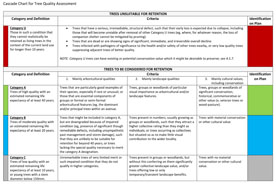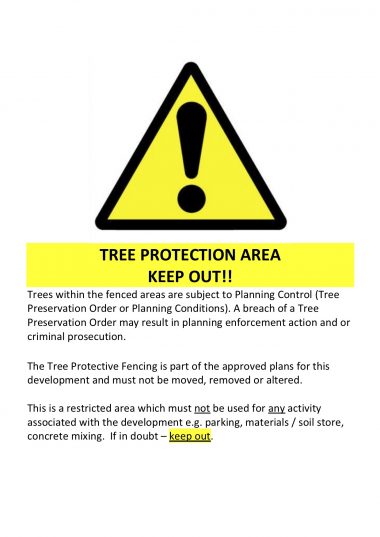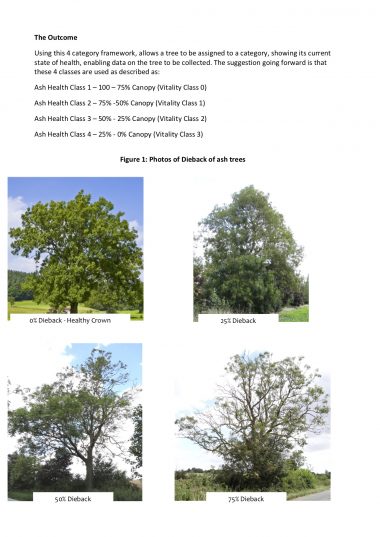Glossary of terms
This glossary is not a complete or comprehensive set of terms of reference. The intention is for this to be an ongoing work relating to technical terms which might be encountered in reports prepared by Objective Tree Consultancy.
Our aim is to provide our reports in plain, simple English. But, there are some terms which are technical in nature and need to be set out in this way. Further explanation for non-professional readers may be required and that is the intention and scope of this glossary.
As we encounter and report on more tree and site attributes, so this glossary will grow. If something isn’t clear or we haven’t explained something properly then please contact us, so we can help you.
Click on the required first letter of your word to quickly search the database:
A | B | C | D | E | F | G | H | I | J | K | L | M | N | O | P | Q | R | S | T | U | V | W | X | Y | Z
A
Ambient light – refers to indirect sun-light as opposed to direct sun-light which would normally enter a property from the east – north-west directions (season dependent).
Amenity – provides benefits or advantages (trees typically within a public place or private space which can be seen from a public vantage point/s). Highly ambiguous in terms of interpretation, not defined in the Town & Country Planning Act and continues to be an issue of dispute and contention.
Apical dominance – the process by which growth hormones regulate branch form with the apical buds on the branch tips being a controlling part of the tree. Conifers and some broadleaved trees have highly regulated form due to this process with clearly developed central leaders and consistent crown form and branch structure.
Arborist – a person with the training and competence to carry out practical tree care operations. Sometimes referred to as a tree surgeon or tree / tree work contractor.
Arboricultural Association – the trade and professional body in the UK which represents arboriculture. www.trees.org.uk
Arboriculture – the care and management of trees for amenity.
Arboriculturist – a person with the training, knowledge and competence in the field of amenity tree care.
Return to Top of Glossary
B
Biosecurity – a series of processes and precautions to help reduce or eliminate the introduction of harmful pests or pathogens to the UK.
Brown rot – decay within woody tissues where the cellulose is preferentially degraded leaving the lignin in a modified state. This can lead to a loss of tensile bending movement and brittle fracture.
Return to Top of Glossary
C
Canker – an area of bark death which can result in a sunken lesion or target shaped feature. Caused by a range of fungi, fungi-like organisms and bacteria pathogens.
Cavity – an external or internal void formed by the process of decay. A cavity may develop within a tree and not be visible externally.
Cellular confinement system – a two or three-dimensional product (typically plastic grid system) designed to hold a fill material for the purpose of soil stabilisation or to provide a load bearing surface
Chlorosis (Chlorotic) – symptoms seen in the leaves indicating low chlorophyll content and associated with low nitrogen uptake / availability or raised soil pH
Companion shelter – a group of trees or woodland that provides shelter for the group / woodland. Typically, the trees will have a closed canopy or be within the immediate vicinity in order to provide shelter.
Competent person – a person who has the training and experience relevant to the task being undertaken and an understanding of its requirements.
Compression fork – forms at the point of division between two branches or stems where growth cannot take place. In response to loading, lateral extension growth may develop on each side of the fork to create ‘ears’ or adaptive growth. Initially thought to be a weakness, recent research has shown these growths to be heavily lignified and of considerable structural support.
Cornish-hedge – a stone faced, earth core structure which might support vegetation. Typically forming field boundaries in Cornwall.
Coppice – a management technique typically applied to broadleaf trees. It requires the cyclical cutting down of growth to the coppice stool (above ground level but typically no higher than 1.0m above ground level). A winter operation.
Crown lifting – the pruning / removal (in part or in full) of branches within the lower crown to achieve a stated height or clearance above ground level or another feature. BS3998:2010 “Tree Work – Recommendations” provides a full detailed description of this process.
Crown reduction – the pruning of the outer parts of the tree canopy to reduce the overall size of the tree, typically by no greater than 30% of the leaf bearing parts of the canopy. This should normally leave the tree with a natural and flowing canopy outline, a tracery of small branches and viable points to sustain re-growth. BS3998:2010 “Tree Work – Recommendations” provides a full detailed description of this process.
Crown thinning – the systematic removal of small diameter branches from throughout the crown, leaving an even density of foliage. Thinning a crown by no greater than 30% of the leaf bearing parts of the canopy and without creating branches only with end weight (see ‘lions tail’ description) would be an objective of this operation for some species. BS3998:2010 “Tree Work – Recommendations” provides a full detailed description of this process.
Return to Top of Glossary
D
Defect – within a tree this is any feature which creates a weakness, compromises safety or the longevity of the tree.
Drip-line – refers to the outer edge of the canopy.
Duty of care – please refer to the Occupiers Liability Act for a detailed explanation of this requirement. The National Tree Safety Group publications also help explain this requirement in the context of tree risk management.
Return to Top of Glossary
E
Endemic – refers to something which is found or experienced within a specific local area. Endemic winds in Cornwall are normally prevailing from the south-west. Cornish Elm is endemic to Cornwall.
Endoscope – often a camera mounted onto a flexible cable attached to a screen. Can be used for identifying a cavity extent or to preclude the presence of bats.
Exception Notice – may be applied to trees within a Tree Preservation Order or Conservation Area in specific circumstances e.g. the removal of deadwood or a dead tree, or the removal of a tree (or part thereof) where it poses an imminent and significant risk of harm. The submission of an exception notice should be submitted to the LPA five working days before the stated works are to be carried out. In the event of the works being required immediately for safety reasons, the exception notice may be submitted within a timely fashion on completion of the works, with evidence to support its use.
Exudate – normally referring to the excretion through the bark of a substance as a by-product of fungal colonisation.
Return to Top of Glossary
F
Fibre-buckling – under a compression loading, wood fibres around a branch base or on the stem may fail. This failure can result in what appears to be congested bark or a partial ring of growth as the fibres losing their longitudinal direction of growth and becoming congested and compressed.
Five Day Notice – see Exception Notice
Fungal bracket – the emerging fungal fruiting body which may be non-persistent (decomposes rapidly e.g. Dryads Saddle) or persistent (woody and durable e.g. Ganoderma australe).
Return to Top of Glossary
G
Ganoderma spp – a genera of specialist heartwood decay fungi which are typically associated with decay in the roots, lower stem and main stem of a range of tree species.
Geo-textile – a woven, man-made fabric. In a tree context, this would normally be used to refer to a weed-suppressant matting or component of a landscaping scheme to separate layers of soils and substrate material.
Return to Top of Glossary
H
Haloing – the process of thinning or clearance of trees / shrubs from around a veteran tree to reduce competition for resources.
Hazard – anything with the potential to cause harm.
Hazard-beam – a term to describe the longitudinal failure of a root or branch where the forces go against the curve or direction of growth. The tension and compression forces lead to the separation of the woody tissues along the length of the failed material. The failure may stabilise as the tensile forces neutralise the compression loading.
Heartwood – the non-living inner section of a tree e.g. Oak. This may occur on a stem, branch or root and is based on size and age. Heartwood is typically heavily lignified and durable.
HSE – Health & Safety Executive are responsible for publishing, regulating and enforcing health and safety requirements within the UK.
Hung-up – when a tree has failed at the roots or stem base and fallen, becoming caught and held up by other trees.
Return to Top of Glossary
I
Incipient decay – early stage decay of woody tissues which may lead to discolouration but without conferring any obvious loss in strength.
Included union (bark included union) – where the point of growth between two branches / stems is weakly attached and woody tissues do not form as with an open fork. The bark of both sides of the point of attachment does not fuse together.
Return to Top of Glossary
J
Japanese Knotweed – a highly invasive plant species which can colonise most soil types. Difficult to eradicate and can delay or complicate any development proposal. Identification, control, treatment, monitoring and eradication are key principles to adopt on any site to prevent cross contamination with unaffected areas.
Return to Top of Glossary
K
Kretzschmaria deusta – a fungus which may be found on the roots, buttresses, stem and occasionally in the aerial parts of a range of broadleaf trees. The fruiting bodies can be difficult to identify due to their size, appearance and location. Recorded as causing a brittle fracture due to a reduction in tensile strength.
Return to Top of Glossary
L
Lapsed pollard – a pollard tree where the pruning (pollarding) management cycle has not been implemented and the tree has been allowed to grow significantly. Results in large diameter stems arising from pollard heads. Can be problematical bring them back into management, due to excessive wound size creation and the loss of leaf bearing material.
Lever arm – in tree terms it refers to a branch or the tree as the lever, free to move at one end under a load e.g. wind, rain etc.
Lions-tail – a branch which has been thinned incorrectly, removing foliage from the inner-canopy, leaving only foliage on the branch-tips. This can give the appearance of a lions-tail. As some conifers become over-mature e.g. Monterey Pine, branches can also lose foliage to give this appearance.
LPA – Local Planning Authority. Normally the local Council (or a city council, National Park Authority) responsible for administering planning functions, applications, TPO’s etc.
Return to Top of Glossary
M
MEWP – Mobile Elevated Work Platform (cherry-picker) used to provide a safe means of access for some tree work operations
Monolith – normally a retained, standing dead tree, from which the branches have been removed or significantly shortened. This type of feature can be kept where there is a broadly acceptable risk of harm in the event of failure at the root system or stem base. Usually a monolith is retained to provide wildlife habitat benefits as it decays.
Mycelium – the main body of a fungal growth consisting of many branched hyphae which can be microscopic but extensive
Return to Top of Glossary
N
Natural regeneration – naturally occurring tree growth arising from seed dispersal in existing trees. Typically undertaken to promote local provenance of seed and tree resources in woodland situation or for wildlife benefit.
Necrosis – the death of living tissues by various means e.g. pathogens, fire damage.
NJUG – refers to the code of practice by the National Joint Utilities Group (Vol 4) to help plan and carry out underground service installations in close proximity to trees without causing significant harm to tree roots.
Return to Top of Glossary
O
Occlusion – refers to the development of new wood and bark around a wound (see wound wood) leading to the wound becoming occluded over a period of time.
Occupancy – used mainly in terms of tree risk assessment to identify the amount of time people might be within a given space. The occupancy rate is derived to determine the amount of time the space is occupied by human targets, that could be at risk from a tree or part thereof failing and causing harm.
Return to Top of Glossary
P
Pathogen – an organism which can cause disease in another organism. In trees this might be a range of microscopic organisms e.g. Phytophthora.
Permeable – allowing the movement of liquids or gases through another layer e.g. tarmac, geotextiles.
Probability – used mainly within risk assessments to determine the likelihood of harm arising from a tree or part of a tree causing harm.
Primary branch – a branch which develops first in order from the parent stem or trunk.
Return to Top of Glossary
Q
QTRA – Quantified Tree Risk Assessment.
Return to Top of Glossary
R
Reaction growth – a tree forming new wood in response to loading or mechanical stress. A normal and healthy tree may form new wood to support branch attachment or in response to wind loadings.
Reaction zone – typically developing near to an area of damage or fungal colonisation. The tree is trying to inhibit it’s spread by forming chemical barriers. Normally written in terms of invasive decay detection analysis.
Rib – a ridge of wood that normally forms in response to loading or torsional forces.
Root collar – the area of the tree between the roots and the lower stem, just below soil level.
Root-plate – the structural part of the root system required to keep the tree firmly anchored into the soil (differs from the feeder roots which are fine and have great volume but are smaller in size).
Root Protection Area – defined within BS5837:2012 “Trees in relation to design, demolition, and construction – Recommendations”. The minimum soil rooting area to be retained to allow a tree to maintain its health and viability. This area should be protected during development.
Return to Top of Glossary
S
Secondary branch – a smaller branch which originates from a primary branch, second in order and typically further out from the parent stem or trunk.
Stress – in terms of plant health and physiology, the functions of the living system are impaired. This may be due to a range of factors e.g. drought, cold, soil compaction etc. This may manifest itself in various ways including (but not exclusively) – crown die-back, sparse foliage, small foliage etc.
Structural roots – those which provide a structural function for anchorage and stability.
Return to Top of Glossary
T
Topping – a poor pruning / arboricultural practice. Results in a complete loss of crown form, excessive wound size and is not recommended by competent arborists.
Torsion – a loading applied with a twisting motion
Tree Preservation Order – a planning constraint which might be applied in certain circumstances by an LPA to afford legal protection to trees with amenity value.
Tree Protection Plan – shows trees or shrubs to be retained within a development / construction site and methods for their protection. Relates to BS5837:2012 ‘Trees in relation to design, demolition and construction – Recommendations’.
Return to Top of Glossary
U
Understorey – may consist of shrubs, small trees or young trees of the dominant high canopy layer which may naturally regenerate or be planted within a woodland or group of trees.
Return to Top of Glossary
V
Vertical mulching – a process of creating a beneficial soil rooting environment by increasing soil pore space and adding bulky organic matter or other soil amendments.
Vigour – relates to the overall growth and performance of the tree.
Visual Tree Assessment – a structured approach to tree inspection looking for biological and mechanical defects (Mattheck & Breloer 1994).
Vitality – normally refers to the ability of the tree to respond to wounding, disease or stress.
Return to Top of Glossary
W
Wind-throw – the uprooting and blowing over of a tree caused by wind loading causing structural failure of the root-system.
Wound wood – the formation of new wood to occlude a wound or injury.
Return to Top of Glossary
X
No entries in this section to date
Return to Top of Glossary
Y
No entries in this section to date
Return to Top of Glossary
Z
No entries in this section to date
Return to Top of Glossary
Top


